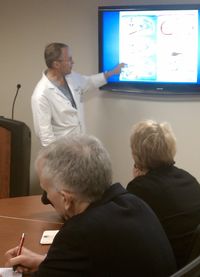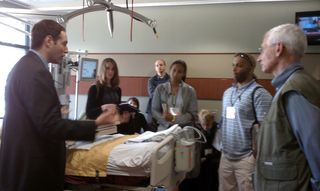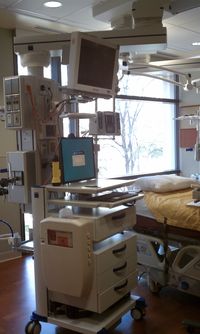Part of the group from the Association of Health Care Journalists meeting being held on Philly this week continued their tour of Penn Medicine at the new state-of-the-art Neuro-Intensive Care Unit (Neuro-ICU). The  Neuro-ICU experts worked as a team to describe this burgeoning sub-specialty and walk the reporters through the unit.
Neuro-ICU experts worked as a team to describe this burgeoning sub-specialty and walk the reporters through the unit.
"One-fifth of the body's blood is pumped to the brain," explained M. Sean Grady, MD, chair of Penn Neurosurgery, as he described the different kinds cases seen here, from traumatic brain injury or penetrating trauma, stroke, hemorrhage, spinal cord injuries, brain infections, brain tumors.
Reporters were surprised to hear the staggering statistics about traumatic brain injury: it is a silent epidemic and the leading cause of death and disability among people under 45. Every 15 seconds, a TBI occurs, with 100,000 deaths and 500,000 disability caused by TBI each year.The Neuro-ICU team works hard to translate research from the basic science conducted by the Center for Brain Injury and Repair to the patients.
Josh Levine, MD, co-director of the Neuro-ICU, recounted one TBI patient's case: while training for a triathalon, Candace Gantt was struck by a truck and suffered a severe brain injury. She was brought to HUP emergently, where she spent weeks in the Neuro-ICU, followed by extensive rehabilitation. A few years ago, she got back on her bike and completed a 'half-iron' triathlon. And they were proud to report that, this Monday, Candace will be competing in the Boston Marathon, wearing a shirt saying "Made Possible by Penn Neurosurgery."
 The team is developing techniques to improve outcomes beyond the initial injury by detecting and treating the secondary injuries that emerge in the the 1-2 weeks following the primary injury. In the state-of-the-art unit, the team can monitor brain oxygen, blood flow, temperature, blood chemistry, structural changes seen in CT scans, all at the bedside. Dr. Levine noted, "with this data, we can personalize care for each patient and study the outcomes to make care better for all patients."
The team is developing techniques to improve outcomes beyond the initial injury by detecting and treating the secondary injuries that emerge in the the 1-2 weeks following the primary injury. In the state-of-the-art unit, the team can monitor brain oxygen, blood flow, temperature, blood chemistry, structural changes seen in CT scans, all at the bedside. Dr. Levine noted, "with this data, we can personalize care for each patient and study the outcomes to make care better for all patients."
 Reporters had a variety of questions about the motivation behind the design of the 22-bed unit, which opened in 2009. Nurse Manager, Mary Ledwith, RN, BSN, explained that even the layout of the unit is advanced - from the open floor plan allowing the specially trained nurses to work together and monitor patients through glass windows in each room, to the large but uncluttered patient rooms where nothing is attached to the wall so patients' beds can be turned towards the large windows. The boom system (shown at right) attaches the IVs and many monitors to the ceiling, leaving the bed untethered while providing more access to the patient's head. And, the chairs in the room, which turn into beds, ensure that families are comfortable and can stay with their loved one as long as they need.
Reporters had a variety of questions about the motivation behind the design of the 22-bed unit, which opened in 2009. Nurse Manager, Mary Ledwith, RN, BSN, explained that even the layout of the unit is advanced - from the open floor plan allowing the specially trained nurses to work together and monitor patients through glass windows in each room, to the large but uncluttered patient rooms where nothing is attached to the wall so patients' beds can be turned towards the large windows. The boom system (shown at right) attaches the IVs and many monitors to the ceiling, leaving the bed untethered while providing more access to the patient's head. And, the chairs in the room, which turn into beds, ensure that families are comfortable and can stay with their loved one as long as they need.
In addition to patient care and research advances in the Neuro-ICU, Dr. Levine also explained the educational advances in this rapidly growing field, here at Penn Medicine. The Neurocritical Care service, which was formally established in 2004, now teaches medical students, interns and residents and has 6 fellows training in neurocritical care currently (up from 4 last year).They're also partnering with the Children's Hospital of Philadelphia (CHOP) to help them establish a pediatric neurocritical care service next door.
If you missed the tour and would like to learn more about the Neuro-ICU team, let us know! We'll be tweeting from AHCJ this weekend (@PennMedMedia), so stay tuned!